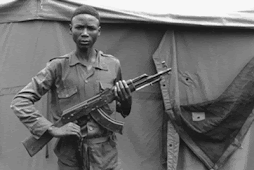"Blood" or "conflict" diamonds are illegally traded diamonds that originate from areas controlled by forces or factions opposed to legitimate and internationally recognized governments. They are sold and their profits used to fund military action in opposition to those governments. The vast majority of Blood Diamonds originate from war-torn regions in Central and West Africa such as Sierra Leone, Democratic Republic of the Congo and Angola. (1)
How can blood diamonds be distinguished from legitimate diamonds?
A "Certificate of Origin" is needed to prove the legitimacy of the diamonds being exported from government controlled areas and regions. These certificates impose extensive requirements to prove the legitimacy of the stones being exported. Monitoring by member states and members of the diamond industry help to ensure only legitimate diamonds reach the market. Government legislation against those areas who do not comply with these policies can be imposed. (1)
How can Blood Diamonds be eliminated?
The Kimberley Process was created in 2000 by the United Nations, several governments and diamond industry members in Kimberley, South Africa. The Kimberley Process is a multi-national trade agreement working to ensure all diamond exporting countries are exporting gems of legitimate and conflict-free standards. It was created as an effort to reduce the bloodshed occurring in Africa by rebel groups using the proceeds of the illicit diamonds to fund civil war and attacks against governments. It is open to all countries willing to implement its requirements and presently hosts representatives from 74 countries worldwide. The vast majority of exported diamonds come from legitimate countries such as Canada, Belgium, Australia and Russia; however, even the 1 % of illegitimate diamonds who remain in the market cause a remarkable amount of suffering and violence throughout the war-torn African regions. (2)
Present-day Africa
Angola, the Democratic Republic of Congo, Sierra Leone and Liberia suffered through nearly a decade of civil war in the 1990’s and into the early years of 2000. These countries are now at peace and are members of the Kimberley Process. The four African nations are producing a large percentage of the world’s conflict-free diamonds; their profits are helping to contribute towards a more stable infrastructure in the young democratic regions. The Ivory Coast remains the last African country to have sanctions brought towards them as a result of some remaining small scale conflict involving blood diamonds. Although the Ivory Coast remains a member of the Kimberley process, its diamond exportation rights have been suspended and the country remains under a UN Security Council Resolution until they can meet the requirements of the Kimberley Process agreement. Through the efforts of the Kimberley Process, a large number of national governments and members of the diamond industry, the percentage of blood diamonds on the market has been reduced from 15% in the mid-1990's to 1% in the last decade. (3)
Diamonds remain a source of controversy
Saturday, May 17, 2008
Subscribe to:
Posts (Atom)


